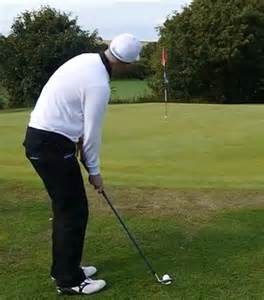
It’s a long Par 4 and the average golfer finds his or her ball 40 yards from the pin. The golfer who has mastered the pitch shot will settle the ball on the green, and then take two putts for a 5 – on the way to a round in the high 80’s or low 90’s. But for the golfer whose pitch shots ricochet around the course like a wayward pinball, a different outcome may be experienced. Using too much wrist, the ball falls short of the green and into a bunker. Four shots later, a tap in putt adds a 7 to the scorecard. Breaking 100 will now be difficult.
The pitch shot anchors the short game and is one of most important shots in golf when it comes to lowering a handicap for an average golfer. Unfortunately, says PGA Professional Mike Moyers of Greene Hills Club, many golfers miss-hits pitch shots because of the way they set up.
“They square up way too much,” Mike suggests.
For a pitch shot, Mike teaches his students to open up more by moving the left leg out of the way. The shorter the shot, the more open the stance.
Mike explains that when “pitching” a softball underhanded, it would be very difficult if the body faced third base and remained there while pitching to the catcher. Rather, as the arm starts forward, the lower body turns to get out of the way. This is the general concept behind the pitch shot in golf.
The ball position is also critical, Mike notes. “The ball is under the center of the breastbone, even though the stance is open,” he says. “The weight is slightly left, about 55% versus 45% on the right leg. The chest and shoulders, however, remain centered.”
The purpose of this set up is to get the body out of the way during the swing.
Because a golfer squares up on a pitch shot, he or she is forced to swing with the wrists in order to get the necessary club speed. The same golfer is also likely to take too wide of a stance. A narrow stance, with the heels 6- to 12-inches apart, allows the golfer to rotate the lower body and “trap” the ball with the swing rather than attempting to “lift it.”
“We want to take a mini golf swing with the pitch shot,” Mike adds.
“On the backswing, the club needs to be hinged more vertically on top of the hands and that angle is maintained through impact.”
Letting the club essentially fall down and trap the ball, or strike downward as the body turns out of the way, results in a more penetrating ball flight with more backspin.
Trying to lift the ball with the wrists often results in a fat shot or a skulled shot.
Which club? It depends on the distance and pin position.
Many golfers today carry at least 4 wedges in their bags – the pitching wedge, gap wedge, sand wedge and lob wedge. With the same swing, these
4 clubs will result in varied distances. The golfer also may vary his backswings from a 7 o’clock to an 8 o’clock or a 9 o’clock. Mike further explains that by using three backswings and 4 wedges, the golfer now has 12 shots with one basic swing.
Mike noted that professional golfers with great short game skills basically have one swing that they have perfected. Then, by using different wedges and different lengths in back swings, they are able to hit an almost endless variety of shots.
That is the goal of the golfer: to develop one basic swing for pitch shots for consistent results. The best way to achieve that goal is with a golf professional at your side so that you can “feel the shots” for yourself.
Mike Moyers, considered one of the finest teaching professionals in Central Virginia, is available for individual instruction. With 1 or 2 lessons, he can help you develop that one, perfected swing that will help you get closer to the pin and lower your handicap dramatically. Call him at 434-985-728, extension 23, for more information.

